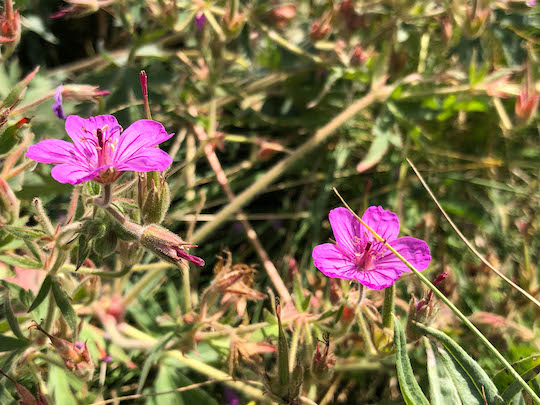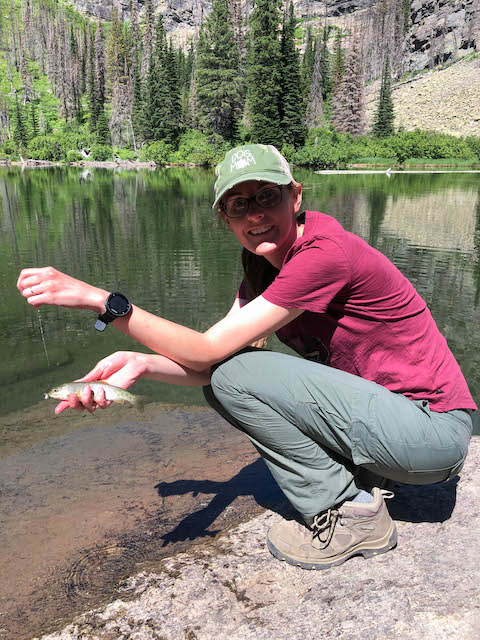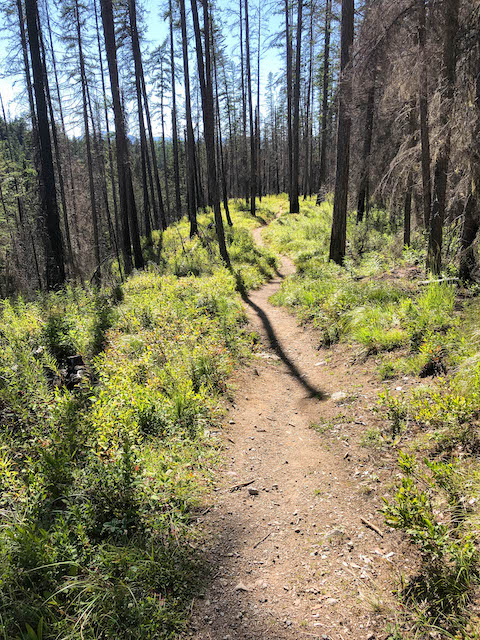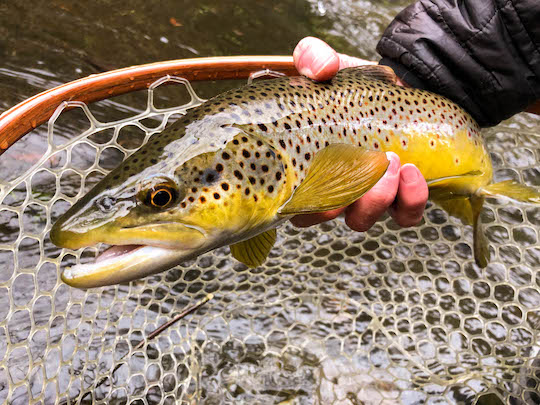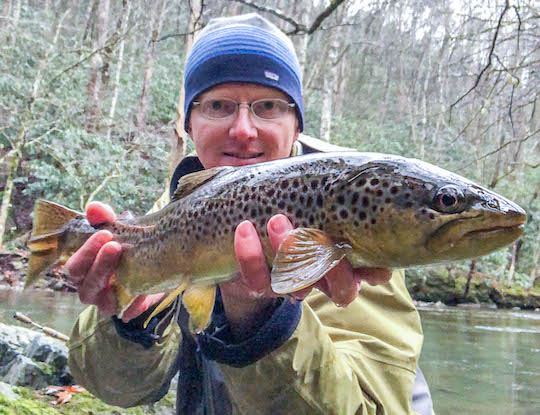This was our last short day before we attempted a big hike. When I say short, some people might disagree as we put about 7 miles on our boots. We were starting to get in a good hiking rhythm, though, and were about ready for much bigger things. To obtain parking, we did our usual early start and caught yet another amazing sunrise. Probably we should have been up another hour earlier and tried to catch the sunrise from Logan Pass, but getting up at 5:00 am seemed reasonably early to both of us but 4:00 am not so much.
Featured Photo: Native Colors

Tuesday, January 12, 2021
Glacier Day Four: Hiking to Avalanche Lake and Going Back to Polebridge
Friday, January 08, 2021
Glacier Day Three: Hiking to Hidden Lake, Pole Bridge, and Fly Fishing the North Fork Flathead River
One advantage of the early starts we were getting every day was the chance to enjoy sunrise every morning. This is something I always enjoy as a fishing guide since I’m often on the road by five or six each morning. For this day of hiking, we hit the road by about 5:30 am and were none too early. We got one of the last parking spots when we arrived at the Logan Pass Visitor Center around 6:30 am.
Our plan was to wander down to Hidden Lake and maybe even enjoy some fishing. This lake is supposed to contain Yellowstone cutthroat trout that are relatively easy to catch. The Tenkara rod was packed accordingly along with snacks, bear spray, water, and of course our cameras. We had our quick breakfast of fruit, granola, yogurt, and nuts and noticed quite a few other people doing the same thing. Soon we were done and ready to start moving.
Hiking to Hidden Lake in Glacier National Park
As we walked across the parking lot and up the stairs to find the beginning of the trail behind the visitor center, we were excited for what the day might hold. This excitement was quickly tempered when we found a sign at the beginning of the trail announcing a closure from the overlook onward. Apparently, the trail was closed because the cutthroat were spawning, and the bears were concentrated in area of the outlet stream looking fish to eat. Another bummer, but also another reason we need to return to Glacier National Park for another try. Still, we were already there and ready to walk. Up to the overlook we went.This was the most crowded trail we hiked in Glacier with only the Avalanche Lake Trail being anywhere close. The reason for these trails’ popularity becomes obvious when you realize that they are two of the shortest trails and also two of the more scenic. Soon, we would be looking for longer hikes that would offer more solitude. At this moment, though, we were just happy to be tourists and see the sights.
The trail is a boardwalk for quite a distance. This helps protect the fragile alpine environment (please stay on the trail!!!) and also inadvertently provided some type of structure for marmots to live under. We found one of my favorite creatures of the Rockies early in our hike, and I had to stop for some pictures before moving on.
The trail heads slowly uphill towards the southeast flank of Clements Mountain. Wildflowers were abundant here. While I was tempted to pull out my good camera, I kept using my cellphone and snapped a few quick shots of the glacier lilies which reminded me a lot of the trout lilies back home in Tennessee. In hindsight, I wish I had spent more time photographing them as we wouldn't find many more during our time in Glacier National Park. I didn't realize it at the time, but we were already late in the season to be finding them. Most of the specimens we saw were already starting to fade and wilt.
Mountain Goats Near Hidden Lake Overlook
Soon enough, the mountain goats wandered off and we turned back to the scene before us. Hidden Lake is spectacularly beautiful. I hate that we didn’t get to hike on down to the lake, but we enjoyed the views we had and the extra time it saved allowed us to enjoy some other portions of the park.
Finishing the Hidden Lake Overlook Hike
Fly Fishing the North Fork Flathead River near Polebridge, Montana
The warm afternoon breeze had me thinking hoppers. I quickly rigged a fly rod with a big foam bug and was soon wading in my sandals. Surprisingly, the fish would at least check out my offering but were being a little shy. I’m guessing they got at least some pressure based on both the fishermen’s trail from where we parked and also the constant parade of boats going by. At least a few of the passing boats contained anglers.
Finally, after switching flies a few times, I settled on a small yellow stimulator and was soon catching plenty of fish. They weren’t really picky exactly, but they did want something a little more natural. Despite my hopes, there wasn’t a massive grasshopper hatch in progress and the fish were looking for aquatic insects hatching. The bright sunny day had some caddis popping along with a few smaller stoneflies. Interestingly, they weren't as interested in nymphs or pupa patterns as they were in dry flies. Cutthroat trout just really like dry flies!
The fish here are not big, or at least I didn’t find any large ones. They were larger than the small fish at Snyder Lake the day before though. They were also reasonably willing to eat a fly, at least once the correct fly was tied on. I caught a few and offered the rod to my wife, but she declined. I got the idea that she might prefer to continue our search for animals, so before long we were back on the road. It was getting later in the day now, and we hoped to find some wildlife moving about.
Back to Camp For the Night
Apparently it was not meant to be. We made the drive back down to the Glacier Campground via the Camas Road through Glacier National Park. There were some nice meadows but no wildlife feeding in them. The hot weather probably had most of the wildlife either in the woods or at higher elevations. We made it back to camp in time for a leisurely evening. We had another very early start ahead of us to find parking at one of the most popular trailheads in Glacier National Park. Back in camp, we found one last bit of wildlife for the day...Wednesday, January 06, 2021
Winter Light Moods
Last week, I was driving home from a quick exploratory trip to the Caney Fork. The day had been perfect with relatively warm temperatures for this time of year. We had even found a few fish which means the river isn't completely barren. Anyway, I got fed up with the traffic on the interstate and decided to take the scenic route home to bypass any potential slowdowns on the mountain at Monterey. The alternative route I chose was highway 70N which more or less parallels the interstate.
The magic happened as I crested the top of the Cumberland Plateau. The late day sun broke through the clouds to illuminate the trees ahead of me. The rich warm glow was too much for my cellphone although I snapped a quick picture to share with my wife. This time of year, with a low sun angle, we got lots of light magic. With an extended golden hour, the sunsets last longer and are often more dramatic than at any other time of year. However, that isn't the only benefit of low sun angles.
Yesterday, while we are shooting some other unrelated pictures, I happened to glance at the sky as we were wrapping things up. The low sun angle at midday resulted in bright rays slanting through the clouds. Most of the year, there is only a narrow window early and late in the day when this can happen. In the winter, it is possible pretty much all day making it more likely to encounter.
My camera was already in hand. Almost without thinking, I snapped a few quick shots. Once I got the pictures on my computer, I realized that some editing might be in order. In the end, I like the black and white look as it accentuates the play of light across the heavens and minimizes other distractions. The only thing I can't decide between is whether I like a lighter or darker foreground. These are two edited versions of the same original. Which do you like best?
Monday, January 04, 2021
New Year Trip Planning
Every winter, in between fishing trips, I begin planning my fishing for the next twelve months. I also tie flies, clean gear, and make sure everything is ready for another season. This is the slow time, but also the time to start planning for the next adventure. Excitement and anticipation builds as we head towards the first spring hatches in February or early March, and before I know it, we'll be right in the middle of summer with plenty of fishing.
This year might be a little different for me. For those of you who subscribe to the newsletter, you probably already know where this is going. If not, then here is a picture that sums it up perfectly.
We are super excited for Baby Knapp, due this May. Of course, that changes the situation for fishing trips. I doubt we'll be pursuing any major adventures this year. Cross country road trips with a newborn sound like a terrible headache. If I'm lucky, I might sneak out a few times between now and when the little one makes the grand entry. After May, I doubt I'll be out on the water much outside of guiding. I'll probably aim to start getting out occasionally again once things start to cool off. Fall is always my favorite time to get out anyway.
Since I'm not planning any fishing trips for this year, I will be hoping to inspire YOU to get out and travel this year by sharing stories from years past. The current series on Glacier National Park still has a lot more articles. I really haven't even begun to share everything from our Yellowstone trip in 2018 and haven't touched Colorado 2019 either. There are lots of good stories I can share from both.
For those who aren't sure about taking a trip this year, then at least make a plan to get out more locally. For me, I include approximately a three hour radius as my local area. That allows me to take day trips all the way up to the South Holston and Watauga Rivers or down to the Hiwassee. Closer to home, I've got plenty of good trout fishing on the Caney Fork River, Clinch River, and of course my favorite fishing in the Great Smoky Mountains. Even closer to home, I've got smallmouth bass and musky. We are blessed with an incredible amount of water. I hope you are able to get out and enjoy fishing more in 2021. This is going to be a great year for fishing!
If you don't subscribe to the Trout Zone Anglers email newsletter and would like to, please enter your contact info in the signup below. I try to send out an email about once a month. Typical emails will include current fishing reports, links to blog articles, and normally some articles on bugs or techniques that will help you become a better angler. You can unsubscribe at any time of course and we won't sell or otherwise provide your email to anyone else. If you choose to subscribe, I HIGHLY recommend adding TroutZoneAnglers@gmail.com AND david_knapp@troutzoneanglers.com to your contacts and safe contacts lists. Quite a few of our subscribers have found our emails in their spam folders for whatever reason. Thanks!
Sunday, January 03, 2021
Glacier Day Two: Hiking and Fishing at Snyder Lake
Hitting Our Stride on the Trail to Snyder Lake
Bear Safety in Glacier National Park
Snyder Lake Trail in Glacier National Park
Fly Fishing Snyder Lake in Glacier National Park
Fly Fishing Snyder Lake Video
Hiking Back Out From Snyder Lake
Thursday, December 24, 2020
Great Smoky Mountain Brown Trout Extravaganza
Recently, I posted about fishing for post spawn Smoky Mountain brown trout. The first fish of the day was a good one, but as I alluded to in my previous post, this wasn't the end of the day. In fact, it was just the beginning of one of the best days of fishing I've ever had in the Smokies. As you know if you've followed this blog for any length of time, brown trout are right up there with my favorite fish to target, whether its on the fly or otherwise. I also have a real soft spot for brook trout, but in the winter, my thoughts turn to brown trout.
December through February has always been exceptionally kind to me when it comes to brown trout. I've caught my largest brown trout during those months and also had my largest Smoky Mountain brown trout caught in that time frame. The low sun angle means lower light, and I prefer to target cloudy days to further enhance that benefit. Rainy or snowy days are best, but are also an exercise in persistence and perseverance. Fishing in cold rain is not for everyone, and on some days I don't last very long, but the results are hard to argue with.
A few years back, my wife and I took a trip to Yellowstone National Park. Of course, fishing was a part of the trip along with hiking, photography, and general sight seeing. One thing I did in particular was to make time to fish with my friend Bryan Allison to learn some new techniques that would help me become a more well rounded angler and guide. Bryan is an excellent guide covering a variety of waters in Montana and offering some unique trip options that are difficult to find. You can visit his site here.
On our trip, I wanted specifically to work on some trout jigging techniques that he has mastered and are deadly on trout in a variety of waters. Fast forward to now, and you'll find me with a couple of very nice ultralight spinning rods loaded with 4 pound test that rarely if ever see any action. I bought them to be able to offer the option on guided trips, and occasionally mess around with them, but in general I prefer catching fish on a fly rod.
On my recent trip to the Smokies, after catching such a nice brown trout very early in the day on my fly rod, I decided to experiment with the things I had learned from Bryan. My day was already made with that quality brown, so it was time to practice some different techniques. One thing he had taught me was how to use marabou jigs. I figured that was as good of a thing to try as any, so I quickly tied one on and started working it carefully. One huge bonus of using the spinning rod is that you can mostly stay out of the water. That is probably the biggest reason that I try this method more in the winter than at any other time of the year. On really cold days, it keeps me up on the bank, and hopefully away from potential swimming events.
It wouldn't take very long to get things going with the marabou jig. Shortly after nailing my first fish on the fly rod, a golden flash blew up my jig and I was fighting another quality fish. And another, and another, and..........well, you get the idea. The fish were keyed in and ready to chase. Every once in a while the stars align and everything comes together for a great day of catching. Of course, every day is a great day of fishing, but the two aren't always synonymous with each other.
This was really an ideal day to streamer fish, because you want to hit it when the fish are fired up. However, with the falling temperatures and snow starting to fall, I just decided to stick with the trout jigging and stay out of the water as much as possible. The spinning rod was a good way to mostly keep my hands warmer as well. Since I wasn't handling the fly line every cast, I wasn't getting my hands as wet which translated to warmer hands. I still got them plenty wet often enough though. Some quick fish pictures seemed like a good idea to help me remember the epic day that was developing. One other benefit to staying out of the water is that you aren't endangering the redds with their precious cargo of brown trout eggs. Remember to avoid walking in sand and gravel areas in the tailouts of runs and pools. Fish often spawn in these areas and those eggs won't hatch for at least another month most likely.
After that first stop which produced three or four quality brown trout, I moved on up the river. In almost every spot I stopped I found fish. Interestingly, they were all falling into one of three size categories. I've been discussing the lack of truly large fish with my friends lately. Little River seems to be in between big fish cycles. As with most things in nature, numbers of giant brown trout seems to be rather cyclical. Right now, we appear to be on the downside of a cycle. I've seen good numbers of fish up to 18 inches or so, with a few fish pushing on to the 22-23 inch range, but some of the giants of past years don't seem as plentiful. Quite a few of my friends have noticed a similar trend.
On this particular day, I was catching a lot of fish in the 10-17 inch range. The big fish just seemed completely missing in action. When the fishing catching is this good, you normally expect to at least see a few larger trout. I decided to double down and really work some areas that historically hold large brown trout. Yet, it continued to be the same story. Plenty of fish, but no monsters.
I was working up one favorite run and had already caught some fish. In fact, I had some nice browns fighting over my offering at one point. It was just one of those days. Working on up past where I normally see the larger fish, I decided to work on up to the head. This time of year, the fish tend to stay farther back in pools, but it was worth a shot.
As I crept along, I spotted a brown laying on the bottom just upstream. I managed a decent cast and bounced the jig past the fish. Once, twice, three times, it was still as a statue. Suspecting that the fish already knew I was there, I threw one more cast well upstream and began a slow retrieve back past the fish. That was just too much. The fish bolted upstream and out of sight. At no more than a foot long, it wasn't a big fish, but I hate spooking fish ahead of me as they usually alert everything else to my presence. I almost gave up and turned around right there, but something drove me on.
Maneuvering carefully into position, I cast almost straight across. I got one good bounce with the rod tip and something heavy slammed the jig on the drop. Immediately worried about the 4 pound test line, I hoped my knots were good. The drag was set just loose enough while the flex of the ultralight rod absorbed the head shakes. Soon, I slid a gorgeous post spawn female brown into the waiting net. She just about filled up my big Brodin net and pushed the tape to right at 20 inches.
She was lean after the spawn and clearly needed some good meals before winter really set in. I was careful to keep her in the water except for a couple of seconds for a couple of quick pictures. The big net is really handy for these moments. You can rest the fish in the water in between shots, and not risk keeping them out of their element for more than 3-4 seconds at a time. Careful catch and release methods are essential to the preservation of these fisheries as fishing pressure continues to increase every year. If you can't accomplish this, then you should probably avoid fishing for these fish.
The good news about all of these fish is that they can also be caught on a fly rod if you don't want to use a spinning rod. In fact, much of the year, a fly rod is a better tool. However, if you are looking for a way to fish in the winter without getting too wet, then give trout jigging a try. Whether you are fishing in the Smokies or on the Clinch or Caney Fork, this technique works.










